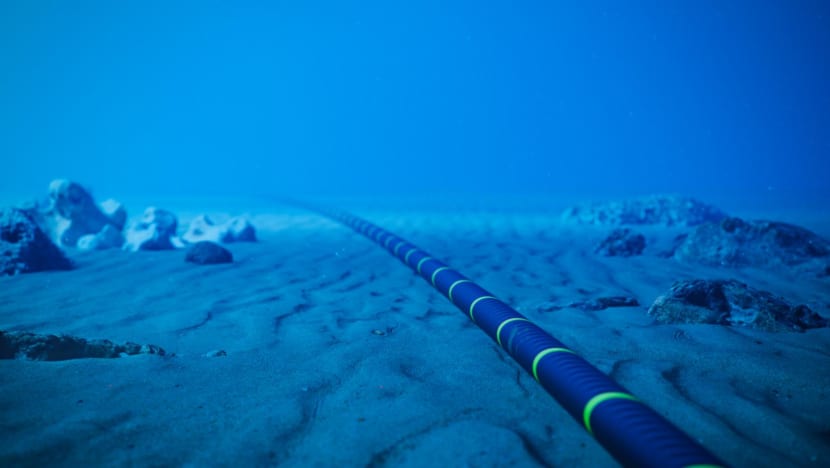CNA Explains: Subsea cables and why it matters when they're damaged
A look at why cable disruptions seem to be happening more frequently, and what's at stake for Southeast Asia and Singapore.

Underwater fibre-optic cable laid on the ocean floor. (Photo: iStock/imaginima)

This audio is generated by an AI tool.
SINGAPORE: In November, two telecommunications cables were cut in the Baltic Sea in a span of 48 hours, prompting suspicions of "sabotage" and "hybrid warfare".
The severing was reportedly linked to a Chinese ship. Beijing has said it's ready to assist in the investigation, while Russia has denied involvement.
A similar incident occurred last year when a Chinese vessel damaged - in a post-facto admission - an undersea data cable connecting Estonia to Sweden.
Since 2022, when Russia invaded Ukraine, there have been at least three incidents of possible sabotage to the dozens of telecommunication cables that run along the Baltic seabed.
What are subsea or undersea cables?
They are fibre-optic lines laid on the ocean floor, to transmit multiple terabits of data per second between continents.
They are said to be as thick as garden hoses, with diameters ranging from 2cm to 5cm or more, depending on whether there's additional protective armour.
According to TeleGeography, a telecommunications market research company, there are more than 600 active and planned cables globally.
These cables are typically designed to last at least 25 years.
They were traditionally owned and operated by telecommunication carriers forming consortiums with parties interested in using the cables.
Over time, more private companies have invested in the infrastructure and today, the big tech likes of Meta, Google, Microsoft and Amazon are either individually or jointly operating subsea cables.
Why are they important?
Subsea cables are seen as critical information and telecommunications technology.
Often described as the "backbone of the global internet", they can carry more than 99 per cent of the world's data traffic, including email, webpages and video calls.
They also transmit more data at a lower cost compared to satellites.
Sensitive government communications also rely heavily on subsea infrastructure, according to the Center for Strategic and International Studies (CSIS).
The United States-based think-tank also noted that subsea cables have helped increase access to high-speed internet worldwide, and thus fuelled economic growth.
How is a cable installed, and what happens when it's cut?
First, seabed surveys are conducted to map out routes for the cables.
A specially-rigged ship then carefully unspools and lays out the cable.
Cables nearer to shores are buried under the seabed for protection from fishing trawlers or anchors.
But in the deep sea, they are laid directly on the seabed.
Damage to subsea cables is relatively common, with up to 150 severed each year, mostly from fishing equipment or anchors, said CSIS.
The impact can vary. A BBC report noted that many countries have more cables than what's minimally required, so even if some are damaged, they can still rely on the others.
However there are times when internet service can be disrupted due to cable cuts, as was the case in East Africa in May.
Apart from physical armour, electronic monitoring systems are also used to safeguard cables.
The systems can detect changes or anomalies in the seabed environment and alert operators of potential harm, CSIS noted.
Why are disruptions happening more frequently?
It's more the case that there's now more attention on these incidents due to the ongoing Russia-Ukraine war and tensions in the Taiwan Strait, said Ms Asha Hemrajani, a senior fellow at the S Rajaratnam School of International Studies (RSIS).
All the same, such geopolitical tensions across multiple hotspots are likely a key factor in some recent subsea cable disruptions, she said.
Ms Hemrajani cited examples such as the Taiwan's outlying Matsu Islands, which had its internet cables severed by Chinese ships early in 2023.
Then there is also the technology rivalry between the US and China, with mistrust spilling over to other key sectors including subsea cables, she noted.
Other hotspots include parts of Europe, as well as the Middle East.
Long-simmering tensions in the South China Sea - most of which Beijing claims - have also affected subsea cables, particularly the process of laying them out.
For example, the shortest route for a cable from Singapore and Japan would be through the massive body of water.
"But various cable operators have mentioned that it’s been getting difficult to get permits from China to lay the cables," said Ms Hemrajani. "The Chinese government has been particularly slow in giving these permits - slow to the degree that some companies have selected alternate routes."
This increases the time and cost of laying the subsea cables. A longer route also means lower speeds, she added.
What are global efforts to protect the cables?
There are several international organisations in this space.
The International Cable Protection Committee (ICPC), for one, was founded back in 1958. It has more than 230 member organisations from over 70 countries, who build, operate and maintain submarine telecommunications and power cable infrastructure.
The ICPC also recently joined forces with the International Telecommunication Union to launch a global advisory board, shortly after the Baltic Sea incident.
At a United Nations General Assembly in September, a joint statement was also issued to declare collective commitment to the security and resilience of undersea cable infrastructure.
Recommendations included encouraging operators to have transparent ownership and partnerships.
"China believes these particular statements are a way to suppress Chinese companies which operate in the undersea cable space," said Ms Hemrajani.
She added that this was an important statement for Singapore - which endorsed it - and its status as an open economy highly connected to the rest of the world.
What's at stake for Southeast Asia?
Undersea cables have become increasingly valuable - and vulnerable - for countries in Southeast Asia, said Ms Elina Noor, a senior fellow in the Asia Program at the Carnegie Endowment for International Peace think-tank.
She wrote in a research paper that by virtue of its geographical location, Southeast Asia is a key node in the web of undersea cables around the world, and acts as a communications gateway to North America and Africa.
By 2025, an estimated 10 major cable projects in and around Southeast Asia are due to come online to meet growing bandwidth demand.
Malaysia, Vietnam and Singapore have been ramping up efforts to boost their subsea cable capabilities.
Malaysia currently has 29 submarine cable networks, including those under construction, and six cable landing stations. By next year, it aims to have the most cables landing in Southeast Asia, according to the Malaysian Investment Development Authority.
Earlier this year, Vietnam also unveiled a plan to construct at least 10 new undersea cable routes by 2030, bringing its total to 15.
As of 2023, Singapore had 26 subsea cables landed across three sites, with plans underway to double the number of sites and add more cables.
What are challenges faced by Singapore?
An RSIS policy report published in May noted that Singapore was "geographically disadvantaged" in efforts to protect its cables, by virtue of it being unable to claim the full suite of maritime zones afforded to it under the 1982 UN Convention on the Law of the Sea due to proximity with neighbours Indonesia and Malaysia.
Another significant risk to cables serving Singapore is from damage that occurs in spaces under the sovereignty or jurisdiction of other states, said the paper, which counts Ms Hemrajani among its four expert authors.
The report recommended that Singapore designate cables and landing stations as critical information infrastructure (CII), and for companies operating these to be designated as CII service providers.
They would then need to notify authorities of any break in service due to deliberate vandalism, acts of war or accidental damage.
Other suggestions included improving cooperation between agencies, as well as partnerships through the Association of Southeast Asian Nations or ASEAN.
"Effective protection of subsea cables requires both regional and international cooperation, and cannot be done by Singapore alone," the experts wrote.



















